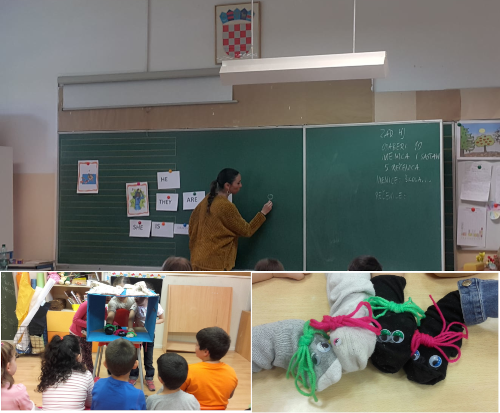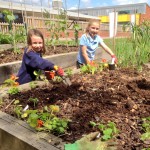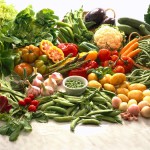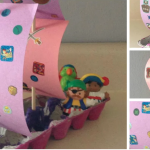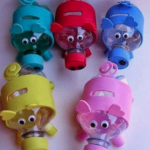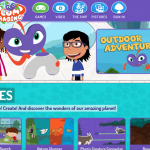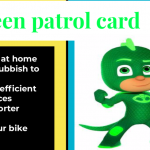Save the planet
Learn through senses
Save the Earth. Get your eco super hero passport!
The importance of having an ecological garden at school
Taking care of our diet is one of the essentials for having a healthy lifestyle. If people have a balanced diet and do sport half an hour every day they are more likely to live longer. Fruit and vegetables are crucial in a basic diet, but it is not so easy to buy organic products in all grocery shops or supermarkets. But, what if we plant them and learn how to create an organic and ecological garden? In this sense, the school is an ideal place to learn how to do it.
Advise to create an eco garden
On one hand, the project of creating and planning an ecological garden allow teachers to work on values and new knowledge such as the different interrelationships that human beings have with nature, the awareness and sensitivity regarding our environment, promoting sustainable values or teach aptitudes to produce and feed ourselves.
On the other hand, these kind of projects boost an active methodology, promote constructive learning that is the one which it does not start from scratch but from the previous student’s concepts and ideas. Besides, foster meaningful learning in which knowledge is not taught in isolation, however is motivated by pupils asking questions to themselves, reasoning about things they are interested in, solving doubts about everything what causes them concern and stimulate their desire to know the world in which they live.
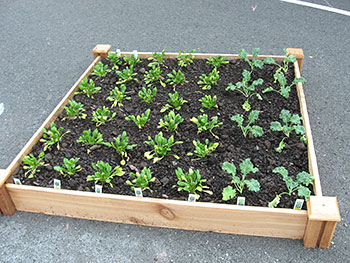
Furthermore, teachers can work different areas of the Primary Curriculum creating and maintaining ecological gardens in order to helps students to develop knowledge and skills for a sustainable living, raising their environmental awareness.
It is an educational tool to promote respect for the environment from a multidisciplinary point of view with which to learn values, important concepts.
Specific goals:
1.- Promote environmental education: awareness of the need to take care of the environment and make children responsible of the use of natural resources. How much water do we need to water a garden? How many times a month or a week? Are the products planted together or separately? Do all vegetables and greens need the same amount of water?
In this sense, children develop what is called the Socratic thinking which encourage them to ask questions fostering the need to know how to answer them, developing critical thinking.
2.-. Know the techniques to cultivate. We must also take into account the climate of the area and its temperature, lighting, humidity, air currents.
3.- Learn how to take care of other living things at the same time that children do that, learn how to take care of themselves.
4.- Learn grandparent’s knowledge and values at other era by asking them how they lived or which diet they used to have. Where do the product came from?
5.-Approach children to the rural world to know where the eggs come from or at what time of the year it is appropriate to plant each fruit or vegetable. Can we plant asparagus in winter or strawberries in August? When is the grape harvested?
6.- Learn how deal with little and home economy: how many people in Andalusia are dedicated to the primary sector? What do we call the primary sector? Ii is ecological agriculture the same as technological agriculture? Can we farm with natural means and supply so many people in society?
Didactic goals:
1.- Learn how plants grow and how function an ecosystem. Observe the evolution of vegetables and greens from the moment a seed is planted until they bear fruit.
2.- To know, to love. Work the land to feed ourselves in a healthy way. Learn how to work land with seeds, fertilizers and water.
3.-Value the products we eat more and make a developing a responsible consumption. If we know where the food comes from and how much it costs to obtain it, we will value it more when it is on our table.
4.- Know the biological cycle of plants
5.- Choose and know the tools we need for it: from the shovel, the rake and the wheelbarrow and know how and why to use each instrument to plant.
6.-Differences between ecological and technological agriculture.
How to set up an school garden:
Criteria to take into account:
1.- Premises:
Location of the garden:
Space we have at school,
Is it the whether sunny or shady in our area?,
Accessibility to water from a nearby place. Do we need watering cans?,
How are we going to get fertile land, a long-term project that needs to involve all the educative community.
2.-What crops are we going to choose?
Vegetables and fruits known by the students,
Where to get the seeds, time of year, needs that these products require, which ones are more resistant to inclement weather, know the germination and life cycle of plants, know the local climate. Can the same seed be planted in a field in the north of the province as in the south? Or in a climate like Almería the same as in Granada?
Green gifts
Roses with papers, spiders with wool scraps, puppets with socks, vases with empty jars or music instruments are gifts that we can make to our friends in their birthdays and save money at the same time. In addition, we will work on our creativity skills, make sustainable and environmental gifts and use recyclable materials that we thought were useless.
you know that a cotton t-shirt cost 2.000 litres of water? An amount sufficient for a person to drink fo more than 900 days. And what about some sneakers?For this, we need 4,400 liters. So instead of giving as a present bags, t-shirts or sneakers, why not give to our beloved friend something that we made with our own hands?
Here are ideas for green and sustainable gifts to make in class:
Do you like painting, sewing or drawing?
There are hobbies that can be compatible with that cool idea that you have in your head for your best friend.
1.-Is your friend a fan of colored pencils and markers and never finds them at home? So take toilet paper rolls, card stock, glue, and cardboard and make an organizer for her study table. Here is this explanatory video
2.- Do you like art and your friend doesn’t know how to decorate his room? Give her a painting made with shapes such as bottles, forks, leaves, lemons, or stoppers.
3.- Or we can build a pirate ship A carton of eggs.
• Long, thin sticks.
• Folios in two different colors.
• Scissors.
• Pirate theme stickers.
• Small dolls (optional).
Paint and brush
4.-And if you want to keep your savings and you don’t know where, make a piggy bank!
Or maybe your friend would like to be a musician and play drums. Make him a drum!
In pinteres you can find thousands of ideas!
Integrated Didactic Unit: Every drop of water, counts
This didactic proposal is based on the educational value of Environmental education, paying special attention to such an important, valuable and limited resource as water. It is aimed at students in the second cycle of Primary Education with the aim of creating awareness and promoting strategies to take care of the water in our daily lives. We are used to letting the tap run when we brush our teeth or when we wash the dishes, or even to leave the tap running while the water heats up when we go to take a shower. Do you know what we could do with that water? Have you ever considered that it could be used to drink in case of shortage, to water plants or mop the floor? Do you know how many kilometers some children have to walk to find drinking water?

Objectives
- Raise awareness regarding water use
- Reflect on how we could save water in our day to day
- Know the accessibility of water in other places
- Communicate through verbal and non-verbal language
- Develop imagination
- Work as a team and develop a spirit of solidarity
- Work on creativity
- Learning strategies of how to take care of limited resources in Earth
Contents
- Learn new vocabulary related to water and nature
- Grammatical structures: Water is important for, I should and I shouldn’t
- Practice numbers in English
- Learn the concept of water footprint
Activities
- Session 1: Assembly: How can we save water?
- Video: The water is important ?
- After that, the teacher split up the class into a group of 4 students. The pupils will make a brainstorming, suggesting ideas of how can they save water in their daily lives.
- Later, they will make a mind map
- Session 2 and 3: Children read a dialogue text.
- Later, they highlight the vocabulary they don’t know such as water pollution, waste or chemicals and some expressions.
- They will adapt the dialogue to have a role play in the classroom.
- Session 4: Good or bad?
- Students will have a card with actions related to the use of water in our daily lives such as 1.-take a shorter shower, 2.- leave the tap running meanwhile brushing my teeth, 3.-chose a shorter program for the washing machine, 4.-put in the laundry basket my clothes when I just used it once. They will classify the cards on the blackboard using I should or i shouldn’t
- Later, they will write these sentences on their notebooks
- Session 5: What is the water footprint and how much water do we need to make a t-shirt or to feed a cow and eat a good beaf steak?
- The students will play a game in which they have to put labels with numbers on the different objects they have brought to the classroom such as oranges, t-shirts, jeans, sneakers a slide of bread and say how much water they think is have been used to make food or textile.
- They will practice numbers in English as well
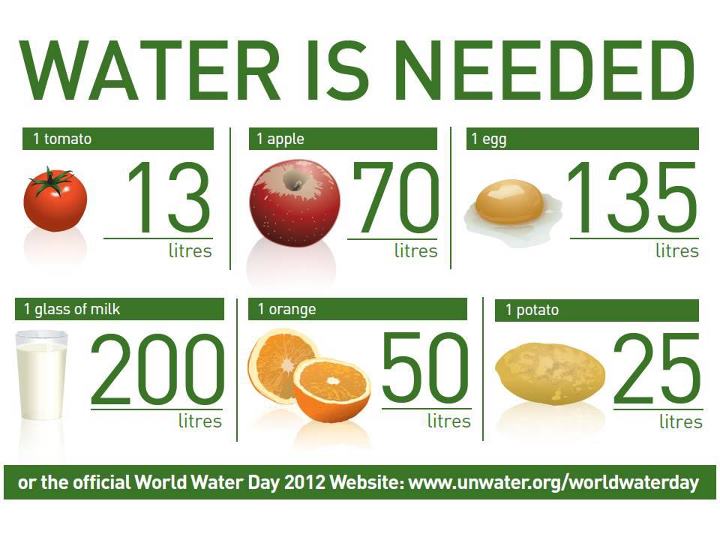
- Session 6: Children calculate the water footprint
- Session 7: Kahoot to practice vocabulary and structures from the unit
- Session 8: Children will explain their mind maps
- Mindfulness class

Online ecological resources
Searching and googling for environmental resources online, I came across this morning with a practical and useful website called Kids Environment which is well-designed and has a wide range of different topic regarding to environmental contents. You have just to scroll down the main window called TOPICS and some others smaller tabs will come up on your screen with some ecological issues such as pollution, reuse and recycle, the natural world, climate change or environment and health. Besides, the website offers good resources, educational material, activities and games to learn other English contents.

Internet presents many resources and games that can be adapted for our English class to work on ecological values. Here I leave you this link in which there are games to create conscious and respectful children. For example, teachers can find sensory and creative games, scientific games, games to save water or games to know how to recycle.
Games to work body language, feelings and emotions
Imitate the sound of the wind with your breath.
Simulate the flapping of the birds with the movement of the arms.
Move at the speed at which some animals move.
Compare silence in nature with that at home.
Play with the footprint that the body leaves on the sand.
Observe the waves that are produced when touching the water.
Games that can be adapted to learn the importance of water
Children must understand that water is the most precious and scarce resource on the planet.
Not using the cistern as a wastebasket, showering instead of bathing or turning off the tap while brushing our teeth are small habits that they will only acquire if they see them in us.
There are simple games that we can introduce into our daily routine, such as incorporating a water meter in the shower to control what we spend.
The reuse of water that we do not really use (such as the first one that comes out before heating) for other needs (watering the plants, rinsing the dishes …) can be a family achievement and a reason for celebration every time savings increase.
My green energy planet sponsored by WWF and the AXA Foundation have launched an online game to promote renewable energy by choosing appropriate ways of life and respecting the environment.
Generation awake, powered by the European Union is an iniciative full of resources to train smart and responsible consumers. I would highlight the section dedicated to short animated films really attractive and appealing to children.
On the other hand, Desembasura is a mobile phone application that allows you to send photos of those places full of waste to show them on the map and report them. You can download it fro free from the app store.“Your smartphone will geolocate you, if you come across a black point, describe what you are seeing and take a photo of it. Thus, automatically, the waste point will be visible on the map “.
In addition, we can find really interesting online games to work on ecological values meanwhile children develops IT competence and Science competente. In this website called Plum Landing students can build up their own ecosystem, make a water safari or observe which animals are in danger in a concrete habitat.
How to integrate Environmental Education in the Foreign Language classroom?
Using Environmental Education as a conducting vehicle to work on the contents of the English Foreign Language classroom in a Primary Education might be a useful resource.
I present a wide variety of activities programmed in a Didactic Unit where transversal contents, communicative approach and constructivist learning are integrated. At the same time, receptive skills (listening and reading comprehension) and productive skills (oral and written production) are worked throughout the different activities .
Therefore, this Didactic Unit includes Environmental Education contents and contents of the Foreign Language classroom itself using different methodologies that facilitate teaching-learning process (Learning based on games, cooperative learning or CLIL).
I link you a power point with a UDI called Save the planet made of myself, which is aimed at the 5th course of Primary Education and might be a guide for you as a teacher to work ecology as a transversal value.
In this sense, I think it is essential to a have clear idea of the specific contents highlighted in the organic law of Education (LOMCE) regarding to the Primary curriculum and how to make an Integrated Didactic Unit taking into account the three basic elements:1.- The curricular concretion, 2.- The Didactic Transpostion and 3.- Learning assessment
Legal Framework
On the other hand, I consider important to have some excellent models as a reference to create our own UDI and takes ideas from them.
The British Council offers some of them : Environment, Do your best, Ali and the Magic Carpet among others.
How to integrate Environmental Education in the Primary curriculum?
There are many ways to include environmental-related content in the classroom. In fact, Mathematics, Social Sciences, Arts, Language and Literature can be used as a common thread to create environmental awareness.
The website called Naturaliza mi aula offers interesting, practical and useful ideas with different activities and teaching resources using four core subjects of Primary Education. This website serves as a model for teachers to carry out activities with their students working on the contents of the Primary curriculum.
1.-I take care of you, you take care of me
Teachers can work on day to day emotions and feelings and the necessary actions that we carry out for our personal care. Later, we extrapolate this content to the care that the environment needs for its own well-being.
2.- Verbs that impact
On the other hand, teachers can work with verbs and nouns in Language and Literature focusing on those that harm Nature.
3.-Measuring well-being
In this activity the teacher can work on additions, subtractions or multiplications, using environmental-themed problems.
4.-Gastón and Gastona
In this activity, students work on the balance of ecosystems to know the importance of biological activity reflecting on the importance of conserving biodiversity.
5.-Sustainable Fractions
Teachers works on fractions, decimal numbers, calculation of the perimeter and the area without neglecting the environmental content. The problems that arise are focused on sustainability and resource management.
This website offers ideas to teachers presenting activities which follow all the curricular elements: activity objectives, evaluation criteria, learning standards and basic competences. Thus, those teachers interested in including this type of content in their classes can follow this reference model.
In addition, we can establish a series of routines in the classroom where caring for the environment becomes relevant. Thus, the tutor teacher can gamify these contents to create enthusiasm and motivate students in this regard.
As well as reading can be used to triggers children’s enthusiasm, rewarding the students who read the most, Environmental Education can also offers the possibility of creating interest and promoting ecological awareness by carrying out a series of activities that will be rewarded in order to achieve the green patrol card.
Do you want to be part of the Green patrol?
These activities can be:
1.-Clean the playground
2.-Plant a chickpea
3.-Pick up rubbish
4.-Change your day-to-day habits
